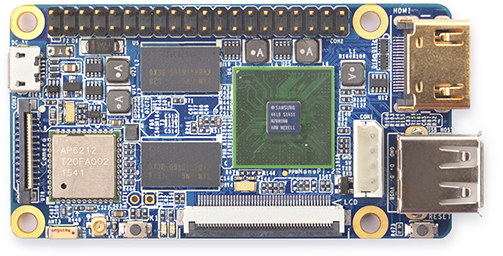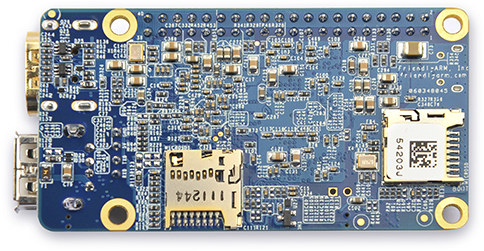FriendlyARM released NanoPi board this summer, a small and inexpensive development board based on Samsung S3C2451 ARM9 processor with both WiFi and Bluetooth connectivity. The company has now unveils a more powerful, and slightly wider, version with NanoPi2 featuring Samsung S5P4418 quad core Cortex A9 processor with 1GB RAM, AP6212 wireless module, a new HDMI output, and the same connectors for I/Os and LCD displays.
- SoC – Samsung S5P4418 quad core Cortex A9 processor @ up to 1.4GHz
- System Memory – 1GB 32bit DDR3
- Storage – 2 x Micro SD Slot
- Connectivity – 802.11 b/g/n WiFi and Bluetooth LE 4.0 via AP6212 module
- Video Output / Display I/F- 1x HDMI 1.4a, 0.5 mm pitch SMT FPC seat for type-A full-color LCD (RGB: 8-8-8)
- Camera – 24-pin DVP interface
- USB – 1x USB Host port; 1x micro USB 2.0 OTG port for power and data
- Expansions Headers – 40-pin Raspberry Pi compatible header with UART, I2C, SPI, GPIOs…
- Debugging – 4-pin header for serial console
- Misc – User and reset buttons, power and user LEDs, RTC battery header
- Power Supply – 5V/2A via micro USB port
- Dimension: 75 x 40 mm (6-layer PCB)
- Weight – 22 g
The board boots from a micro SD card (on the right below) with either Android 4.4.2 or Debian.
NanoPi2 Wiki describes the board, shows how to install the images, build U-boot, Linux 3.4.x and Android, and provides links to the schematics and mechanical files (PDF). The Debian Image Build System (DIBS) and other tools can also be found on ARMWorks github account.
Unfortunately, I could not find the datasheet for S5P4418 processor [Update: here’s S5P4418 user’s manual], but one Chinese company mentions it’s an upgraded version of Exynos 4412, and I’ve passed their comparison table through Google Translate.
| Function |
Exynos 4412 |
S5P4418 |
Advantage |
| I/O Voltage Levels |
1.8V |
3.3V |
No level conversion needed |
| UART |
4 |
6 |
Meets more requirements |
| MEMORY |
4x dual channel DDR3 |
2-channel DDR3 |
Easier wiring and impedance control |
| USB HOST |
Needs an external PHY |
USB2.0 HOST |
Eliminate the need for external chip |
| Display |
RGB/MIPI |
RGB/MIPI/LVDS |
Supports LVDS directly without an external chip |
| I/O functions |
Some I/Os support interrupts |
All I/Os support interrutps |
|
| Networking |
Requires DM9000, which costs more (12RMB ~ $1.9) |
Built-in Gigabit Ethernet, and you can use a 3RMB (~50 cents) chip to support 10/100/1000M Ethernet |
Lower cost |
NanoPi2 board sells for $32, and you can also purchase a kit with a 7″ resistive LCD for $65. Alternatively, 4.3″ and 7″ can be purchased separately for $25 and $35. Sadly shipping is monstrous, as I was asked for respectively $32 and $65 extra for shipping and handling for the board only and 7″ LCD kit with NanoPi2 board. Both match exactly the costs of the board and kit, so hopefully it’s a temporary mistake.
You can find more details and/or buy the board on NanoPi2 product page, as well as on Andahammer, where people from North America should be able to buy with lower shipping fees.

Jean-Luc started CNX Software in 2010 as a part-time endeavor, before quitting his job as a software engineering manager, and starting to write daily news, and reviews full time later in 2011.
Support CNX Software! Donate via cryptocurrencies, become a Patron on Patreon, or purchase goods on Amazon or Aliexpress






